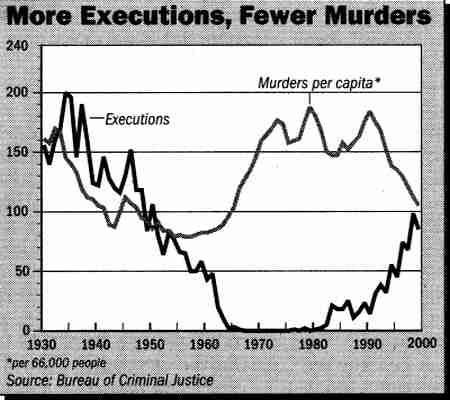 (C) Department of Justice
(C) Department of Justice
I know the graph only calculates from 1950 to 2005, but the message is still there.
Basically, in the periods from 1920-1933 (Prohibition Era), 1963-1972 (Vietnam Era), and 1984-1993 (Crack Epidemic), the homicide rate spiked. In all three of these periods, the cause was obvious: reaction to the 18th Amendment, outrage over the frivolous war in Vietnam, fall in cocaine prices leading to the conversion to crack.
However, homicide and other violent crimes didn't disappear between those periods. It simply fell. Even though statistically, the United States is in a downswing in our crime levels, we're still the nation with the #1 homicide rate in the industrialized world.
Based on some observations, I've been able to narrow down three major sources of violent crime in Modern American Society:
1. Immigration
The FBI contains a list of most wanted murderers. Note, this is not the Top 10 Most Wanted, but this is simply a huge list of wanted murderers. Notice how at least 75% of them are Hispanic. Reading into their profiles, the majority of them are illegal immigrants who've murdered before coming into the US, murdered while in the US and are on the run, or murdered in the US and jumped back over the border to Mexico.
What makes illegal immigrants kill? Well, the majority of immigrants come here looking for cheap labor. Some aren't satisfied with the shoddy work and resort to dealing drugs. The underground drug world is a deadly game where oftentimes, desperate people will do desperate things.
2. Drug Use
About 30% of violent crimes are committed while the accused is under the influence of drugs or alcohol.
The solution wouldn't be criminalize alcohol. We tried that. It didn't work. But perhaps legalizing illicit drugs and regulating their trade could reduce the level of drug-related crimes and certainly bring down the amount of drug-trade related crime by some 90% just as it did bringing down bootlegging in the 1930s.
3. Homelessness/Poverty
 This graph explains itself.
This graph explains itself.Solutions?
Now, it would be easy to say "If we could militarize the border, there'd be less crime," or "If people stopped using drugs, there'd be less crime," of "If there was no poverty, there'd be no crime." Unfortunately, those things are going to happen regardless of what laws are put in place. In fact, it's my firm belief that laws were made to be broken, and the harder the laws, the more people are going to do them.
But perhaps there are other solutions?
One item that people cite as a reason for the continuing drop in crime is the overcrowding of prisons. This creates an entirely new problem altogether, but with more murderers, burglars, vandals, and rapists behind bars, of course there's going to be a huge decrease in incidents. Of course, it also puts a greater strain on our already strained tax dollars.
What about thinking "outside the box" so to speak? In Steven D. Levitt and Stephen J. Dubner's book Freakonomics (which I'm reading at the moment) they cite a very astute timing-related reason for the decline in crime at the time of the Crack Epidemic.
The average age for committing violent crimes would be 18-24. At the time of the Crack Epidemic, 18-24 year olds would have been born before 1973. In that year, a landmark Supreme Court case was handed down: Roe v. Wade. The plaintiff, Norma McCorvey (alias Jane Roe) was the poster-child for single-motherhood: drug abusing, no education, welfare using, and bitter. She fought hard for her right to "choose" but given the fact that legal precedings take too damn long, she ironically gave birth to the baby just before the Supreme Court ruled that abortion was legal in all 50 states.
Fastforwarding to 1993, the crime rate suddenly dropped while all the experts (including President Clinton who warned of a generation of youth who would terrorize America) said it would rise exponentially. No one considered the fact that those who were fostering the Crack Epidemic simply grew up... and the next generation who would be in prime condition for committing crimes (lower class, careless parents, drug-abusing families) simply didn't exist thanks to Jane Roe.
(Ironically, Norma McCorvey later converted to Baptist Christianity and became a firm Pro-Lifer dedicating her life to overturning Roe v. Wade.)
So, aborting babies who are more prone to a criminal life style is one option. Capital punishment is another option.

The graph doesn't lie. Capital Punishment was against public opinion in 1963 (just as homicide levels began to spike) so the courts struck capital punishment down, bringing the total numbers of executions to 0. As you can see, the result was that murder didn't seem like it was punished so badly any more. When Capital Punishment was reinstated in 1972, the number of executions rose dramatically, inversely proportional to the amount of murders being committed.
I'm being increasingly convinced that humanity is a problem that can't be cured... except through death. The only conceivable solutions to curing the homicide rate only end in... more death. If you can come up with a solution to begin curbing our homicide rate, I welcome the proposal. Otherwise I don't see how there could be another solution.
P.S. Based on the timing of the last spikes, watch out for the next homicide spike around 2020.
No comments:
Post a Comment